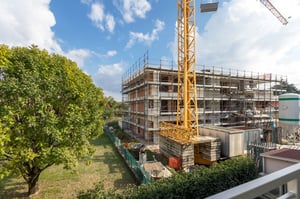In the face of global climate challenges, the construction industry stands at a crossroads, with the opportunity to lead by example through the adoption of sustainable practices. These practices not only aim to reduce the carbon footprint associated with buildings and infrastructures but also strive to achieve sustainability in the industry at large. This transformative approach underscores the urgent need for the construction sector to transition towards more sustainable building practices, ensuring a viable future for subsequent generations. This article explores how to best implement sustainability in construction, focusing on eco-friendly materials, energy-efficient practices and waste reduction strategies.
Understanding Sustainable Construction
Sustainable construction aims to minimise carbon emissions and maximise benefits across environmental, economic and social metrics. It encompasses reusing materials, using recyclable and renewable materials as well as reducing energy consumption and waste production. With the construction sector responsible for significant energy use and up to 37% of global CO2 emissions, integrating sustainability is crucial. The industry faces the challenge of managing its carbon footprint by adopting practices like energy efficiency, using low embodied carbon materials and enhancing indoor air quality.
Key Methods for Implementing Sustainability in Construction
- Prioritising Sustainable Materials
Sustainable construction utilises materials that minimise environmental impact, for example, recycled steel, bamboo, reclaimed wood and low-VOC (Volatile Organic Compounds) paints and finishes. These materials not only reduce the environmental footprint but also enhance indoor air quality and overall building health.
- Energy Efficiency
Implementing energy-efficient systems such as high-performance HVAC and smart lighting controls is also crucial. These technologies result in lower energy consumption and enhance the comfort of building occupants, contributing to eco-friendly structures.
- Waste Management and Recycling
Effective waste management and recycling are vital for reducing the environmental impact of construction activities. Practices such as segregating waste on-site and using recycled materials help divert construction waste from landfills and avoid resource depletion.
- Green Design Strategies
Incorporating green design principles, such as prioritising natural light and thermal mass materials can significantly reduce a building's energy and water usage. Research from the UN Environment Programme indicates that buildings designed with these principles can achieve up to a 30% reduction in energy use and a 50% reduction in water consumption.
Benefits of Sustainable Construction
- Economic Benefits
Sustainable construction not only enhances property values but also reduces operational costs significantly. The combination of energy-efficient systems and high-quality materials often qualify for tax incentives and grants, leading to substantial long-term benefits.
- Environmental Benefits
Adopting sustainable construction practices helps in preserving ecosystems, conserving natural resources, and reducing energy consumption. This leads to a significant decrease in greenhouse gas emissions and a lower carbon footprint for the built environment.
- Social Benefits
Sustainable construction fosters a sense of community and well-being among inhabitants. It emphasises the use of local materials and labour, which not only supports local businesses but also improves community ties.
- Long-term Sustainability
The durability and low maintenance requirements of sustainable buildings ensure their long-term sustainability. These structures are designed to be resilient to environmental changes and natural disasters, which reduces the need for frequent renovations and repairs.
Steps to Implementing Sustainable Construction Practices
1. Conduct a Carbon AssessmentTo effectively implement sustainable construction, conducting comprehensive carbon assessments is vital. This involves assessing the construction company’s carbon emissions for the organisation, as well as the products if applicable. The company would initially carry out a business carbon assessment, this would highlight all emissions produced by the company using a chosen baseline year. If the construction company creates products (such as concrete or steel), a product carbon assessment such as a Life Cycle Assessment or Embodied Carbon Assessment would thoroughly assess the environmental impact of an organisation’s production process and create a clear roadmap to achieve their net zero goals.
2. Setting Sustainable Goals and TargetsSetting clear and measurable sustainability goals is essential. These targets should align with broader sustainability frameworks like the UN Sustainable Development Goals and be tailored to specific project needs and contexts.
3. Engaging Stakeholders and Building CollaborationEngaging a wide range of stakeholders, including investors, regulators, and the community, is vital. Effective stakeholder engagement ensures that diverse perspectives are considered and supports the successful implementation of eco-friendly initiatives in construction.
4. Incorporating Green CertificationsLeveraging green certifications such as LEED, BREEAM, or the WELL Building Standard can guide and validate the sustainability efforts of construction projects. These certifications help in setting industry benchmarks and providing market recognition for green practices.
5. Continuous Monitoring and ImprovementImplementing a system for continuous monitoring and improvement ensures that sustainability goals are met and allows for adjustments based on performance data. This approach encourages ongoing innovation and adaptation in sustainable construction practices
The Bottom Line
Implementing sustainability during construction is essential for reducing environmental impact and promoting long-term resource efficiency. Prioritising reusable materials, embracing energy-efficient practices, reducing waste and enhancing water efficiency during construction can significantly contribute to a greener future. As sustainable construction practices continue to evolve, they will play a crucial role in building an eco-friendlier world, ensuring that future generations can enjoy a healthy and thriving environment.


